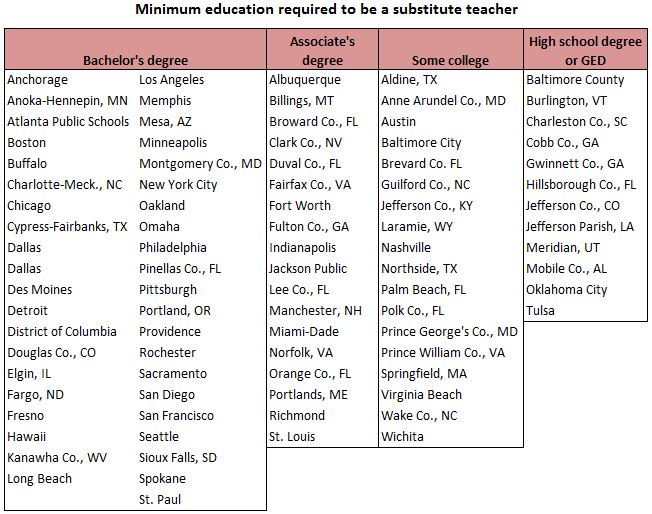May 2013: Substitute teachers
Welcome to Tr3 Trends, NCTQ’s monthly newsletter designed just for school district
officials. Each month we use data from
NCTQ’s Tr3 database to highlight the latest trends in
school district policies and collective bargaining agreements nationwide. Tr3 contains teacher policies from
114 school districts, including the 50 largest districts, the largest district
in each state, Broad Prize winners, Gates investment districts and members of
the Council of the Great City Schools. Teacher policies from all 50 states are also included.
Substitute teachers spend a lot of time with students, yet policies
governing their work don’t often make it into the spotlight. This month we compare districts’ requirements
for becoming a substitute, policies on evaluating subs, and substitutes’ pay
and benefits. Here’s what we found:
Only about half of the districts for which we have
data (45 of 94) require that substitutes have a bachelor’s degree.

Nineteen
districts (20%) require an associate’s degree; 18 districts (19%) require some
college; and 12 districts (13%) require a high school diploma or GED.
States often decide for their districts what
the qualifications of a substitute must be.
In a little over half of all states, substitutes are required to earn a
license or certificate.

The “No” category includes:
Alaska, Arkansas, Georgia, Idaho, Louisiana, Maryland, Massachusetts,
Mississippi, Montana, New Hampshire, New York, North Carolina, Oklahoma, South
Carolina, South Dakota, Tennessee, Texas, Utah, and Virginia.
The “Determined at district level” category includes: Connecticut, Delaware, Florida, Indiana, and Vermont.
12% of districts (14 of 114) evaluate all substitutes

New Haven; Minneapolis; Dekalb County,
Georgia; Brownsville, Texas; Seattle; and Fresno are some of the 14 districts that
evaluate all of their substitutes. An
almost equally large group of districts (12 of 114), including Nashville, Boston, Los Angeles, and Oakland, evaluate only long-term
subs.
In most districts substitute pay varies based
on assignment longevity and/or a substitute’s qualifications. The daily rate of pay ranges from a low of $50 (Baltimore City) to a maximum of $234 (Los Angeles). (This doesn’t include full-time teachers who are assigned to be
substitutes.)
Here’s a
district-by-district breakdown of substitute pay rates:

23% of districts offer health benefits to at
least some substitutes
Chicago, San
Francisco, Houston, Detroit,
and Philadelphia are among the 24
districts we know of that give health benefits to long-term subs, full-time
subs, or subs who work a minimum number of days per year. In Denver, long-term subs
can participate in all district benefits programs “at their own expense,” according to the teachers’ contract.
Duval County,
Florida and Cincinnati
are the two districts that say they give substitutes health benefits but don’t
specify which subs receive the benefits. Cincinnati’s teacher contract says “district substitutes are eligible for the same health benefits and Term Life
Insurance as other full-time teachers, by making the same contribution,” while
a Duval website
says that “health benefits” and a “401k plan” are some of the benefits offered
to substitute teachers.
Go toTr3‘s custom report page to access all the data we use in Tr3 Trends and to compare teacher policies in 114 school districts
nationwide. Send feedback to gmoored@nctq.org.
